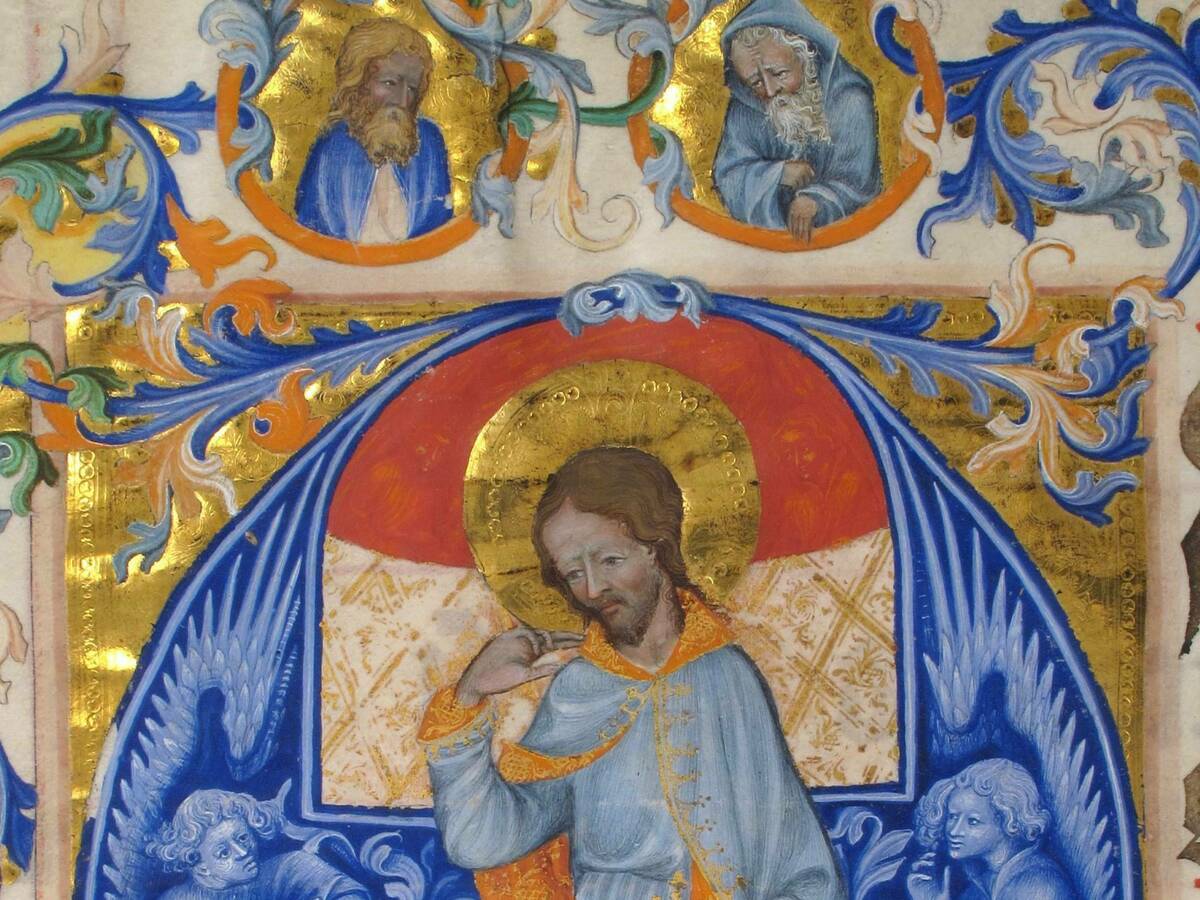In reading literature, the tropological way of reading does not mean we pray the text itself, as we would with Scripture in lectio divina. Though there have been many books published that collect the spiritual writings of an author into one place or are titled The Gospel according to . . . , we need to ask of a book, “Can you live it? Can you put it into action? Can you speak—or adapt—the language of this work, use it to talk to both yourself and others so as to live better?” To read tropologically, the book becomes part of how we live and speak. If a friend is undergoing a crisis, I might cite an encouraging piece of Scripture, but I also might draw from the reservoir of beautiful passages within me from literature or the wise words of geniuses from our tradition. Only because we are out of practice does it seem pretentious in our conversations with others to offer up the best that has been thought and said.
Moreover, we should read new creations of art as tropological readings of texts. When a person reads tropologically, they create in response to what they have internalized—in how they live their life, how they pray, or what they create. McDermott offers the examples of Piers Plowman and other medieval pageantry plays as tropological interpretations of Scripture. George Steiner, a non-Christian critic, stood against his contemporaries the deconstructionist critics when he said that the best reading was to bring forth the presence of the past text. He calls The Divine Comedy the best “reading of the Aeneid, technically and spiritually ‘at home,’ ‘authorized’ in the several and interactive senses of that word, as no extrinsic commentary by one who is himself not a poet can be.” Although Steiner was not functioning under a sacramental paradigm, which assumes the power of texts to be enfleshed, his experience with literature taught him this reality.
“The best readings of art are art,” Steiner contends. When we read a work so closely that it becomes part of how we see the world, then we will create under its influence. We will read all else by its light. Hence, reading Scripture should be our primary and daily reading. “Art develops via reflection and on preceding art, where ‘reflection’ signifies both a ‘mirroring’ and a ‘re-thinking,’” Steiner explains. “It is through this internalized ‘re-production’ of an amendment to previous representations that an artist will articulate what might appear to have been even the most spontaneous, the most realistic of his sightings.” The illusion of originality may deceive us that we should abscond from all influences, but the God who made us in his image calls us, as a salvific imperative, to the imitatio Christi.
The end of all our reading should be contemplation. Our active life, fostered by tropological reading, will be frenetic, fruitless, and unsatisfying without contemplation, which is the way of knowing the Maker of all meaning. To be a contemplative does not mean one becomes a hermit. Rather, as Kathleen Norris indicates in The Quotidian Mysteries, “The true mystics of the quotidian are not like those who contemplate holiness in isolation, reaching godlike illumination in serene silence, but those who manage to find God in a life filled with noise, the demands of other people and relentless daily duties that can consume the self.” We become habituated to contemplating God through our daily lives by the practice of spiritual reading. Balthasar agrees: “Unavoidably, the life of contemplation is an everyday life, a life of fidelity in small matters, small services rendered in the spirit and warmth of love which lightens every burden.”
The way we read books will foster a certain imagination, a particular way of reading the world, in which we ascend toward contemplating God and all his graces or descend into utilitarianism and reduced vision. John Henry Newman writes, “Christ lives, to our imaginations, by His visible symbols.” And not only by sacraments, adds Stephen Prickett, “but by the whole complex web of visual iconography and literary metaphor which has grown from the Bible and the associated traditions of the Church.” If we first closely consider the letters or images of a text, the literal and historical meaning, then dig deeper to explore the allegorical or spiritual significance, we must discern not only how we shall live but also what we have discovered about the One who is our life. In Christian tradition, the anagogical sense refers to a text’s echo or reflection of the divine. Where do we see God here? Or we might equate the anagogical with the eschatological: Knowing that all will end in our death and Christ’s second coming, what matters in what we have read? It’s the cultivation of a sight that points our eyes ever upward toward heaven.
Guigo assumes that the process of contemplation is repetitive within this life, so one is always crafting an anagogical imagination that considers the particular, the spiritual, the moral, and the final ends. These four senses are ways of reading that prepare one for a certain practice of seeing the world, of being a contemplative. Whereas the world trains us toward a utilitarian vision that is consumerist and destructive, the contemplative remains open to mystery and enchantment, beholding what is concrete, seeking the poetic. The contemplative vision is ultimately life-giving.
In his 1945 science fiction novel That Hideous Strength, C.S. Lewis contrasts the lack of imagination of the utilitarian to the contemplative, anagogical vision. At the start of the novel, a group of faculty gathers together at Bracton College to discuss selling off a portion of their property called the Bragdon Wood. The bursar holds up a map and identifies the task at hand as whether to sell the “area coloured pink on the plan, which, with the Warden’s permission, I will now pass around the table.” Notice how the faculty see the land. It has been quantified by acreage, marked on a map, examined on a sheet of paper from a distance. It has no smell, no sounds, no beauty. Instead of a place with a story and a history, the faculty reduce the land to an amenity. They interpret the location by its data, utility, and resources. With this imagination toward their “resource,” the faculty vote to sell the wood.
In contrast with this impersonalized vision of the Bragdon Wood, our unnamed narrator (who is, for all purposes, Lewis himself ) has enjoyed a recent stroll through this particular wood. He describes a high wall enclosing it, and when you enter, you sense a “gradual penetration into a holy of holies.” The narrator invites the reader to join him on this expedition, writing in the second-person you:
First you went through the Newton quadrangle which is dry and gravelly; florid, but beautiful Gregorian buildings look down upon it. Next you must enter a cool tunnel-like passage, nearly dark at mid-day . . . [that bears] a whiff of the smell of fresh bread . . . The grass here looks very green after the aridity of Newton and the very stone of the buttresses that rise from it gives the impression of being soft and alive. Chapel is not far off: the hoarse, heavy noise of the works of a great and old clock comes to you from somewhere overhead . . . You were in a sweet, Protestant world. You found yourself, perhaps thinking of Bunyan or of Walton’s Lives . . . As I went forward over the quiet turf, I had the sense of being received. The trees were just so wide apart that one saw uninterrupted foliage in the distance but the place where one stood seemed always to be a clearing; surrounded by a world of shadows, one walked in mild sunshine.
The difference between these two ways of seeing should be striking. All of the senses are turned on—the smell of bread, the play of the sunlight. The literary allusions to Bunyan and Walton are called up. The hint of the possibility of a divine Host or Giver. Everything in our experience is heightened by his description, our souls evoked by its beauty. When it comes to which way we want to be in the world, the latter accords more with the Christian vision of the world.
However, a contemplative vision has to be cultivated. We do not simply exist as a faculty member examining data or as a man walking through a wood in meditation. We make small, significant choices that form the imagination to see according to one set of lenses versus another. We practice ways of reading spiritually that ascend a ladder toward contemplation. We learn the four senses and practice reading with them.
Editorial Note: This essay is an excerpt from Reading for the Love of God by Jessica Hooten Wilson, ©2023. Used by permission of Brazos Press.


